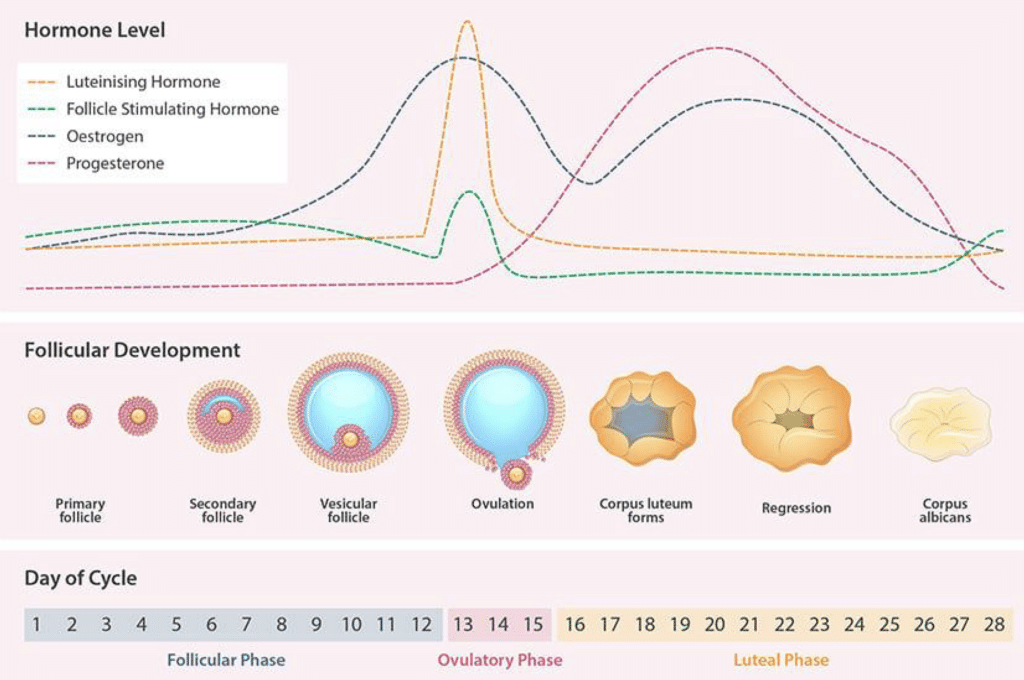Are you tired of enduring monthly discomfort and unpredictable mood swings? If you’re a woman of reproductive age, you’re likely familiar with the challenges of hormonal fluctuations, whether it’s premenstrual syndrome (PMS) or the changes that come with menopause. But what if there was a way to navigate through these hormonal ups and downs with understanding and empowerment? In this guide, we’ll explore the delicate web of female hormones, demystify common hormonal conditions, and reveal steps to achieve hormonal balance for a healthier, happier life.
Your body whispers before it screams – some signs to watch out for:
Your body speaks to you, and it’s essential to pay attention to the signs it gives. While some mild discomfort during your menstrual cycle is normal, experiencing recurring pain, severe mood swings, or abnormal bleeding warrants attention and evaluation.
Some Abnormalities to be Mindful of Include:
+ PMS: excessive fluid retention, increased anxiety, severe low mood and food cravings 2 weeks prior to your bleed.
+ Dysmenorrhea: debilitating period pain
+ Menorrhagia: heavy bleed
+ Oligo-/Amenorrhea: irregular or absent menstruation
+ PCOS: elevated androgens may show signs of acne, facial hair grown, hair loss, irregular cycles and may or may not also be accompanied by cysts on the ovaries.
+ Fibroids: benign growths within the uterine wall, signs include dysmenorrhea and menorrhagia
+ Endometriosis: tissue that normally lines the uterus grows elsewhere (outside the uterus), resulting in dysmenorrhoea, pain during other times in the month and potentially infertility.
+ Adenomyosis: tissue that normally lines the uterus grows into the inner layers of the uterus, resulting in dysmenorrhoea, menorrhagia, and infertility.
Understanding the Hormonal Network
All conditions start when something has become unbalanced – so what does that mean and how do we know when to look at hormones?
Oestrogen and Progesterone Lead The Show
Before delving into the complexities of the female hormonal system, let’s explore the primary players: oestrogen and progesterone.These hormones orchestrate the menstrual cycle, regulating ovulation and the preparation of the uterine lining for potential pregnancy.
Knowing how they interact and affect each other is crucial to understanding the root causes of hormonal imbalances.
Oestrogen and Progesterone rise and fall during the cycle and contribute to maturation and release of an egg – known as ovulation, and growth and development of the uterine lining to prepare for potential pregnancy.
Typically, if the egg is not fertilised after ovulation, the production of oestrogen and progesterone both drop away triggering a monthly bleed. And the cycle begins again. They are supported by FSH which is responsible to help grow and prepare the eggs for ovulation while LH itself triggers the release of the egg.

Test & Assess
Balancing hormones is more than just adjusting the levels of specific hormones. It requires a holistic approach that takes into account the interactions of multiple hormones and compounds. This is why we always test and assess how hormones interact. This allows us to identify underlying issues affecting your hormonal health accurately.
The female hormones are influenced by a whole crew of other hormones and compounds. For example cortisol, insulin, thyroid hormone and androgens such as testosterone all have the capacity to positively or negatively lead to subtle or more dramatic changes to the female reproductive health.
Influencers of Hormonal Health
The delicate balance of female hormones are also sensitive to:
1. Inflammation is a well-known concept, and when it increases, it leads to an elevated production of oestrogen in local tissues. Surprisingly, this means that inflammation can trigger oestrogen production outside the ovaries, which, in turn, can result in higher insulin levels and a decrease in progesterone.
2. Toxins and Endocrine Disrupting Chemicals (EDCs) encompass substances like plastics, perfumes, and makeup. Exposure to these chemicals increases the osteogenic burden on the body, leading to potential consequences such as early puberty, irregular menstrual cycles, and reduced fertility.
3. Mast cells are vital components of the immune system. When triggered by EDCs and oestrogen, they release inflammatory cells and histamine into the pelvic cavity. Although typically associated with allergies, mast cells play a significant role in causing the marked inflammation and pain seen in conditions like endometriosis and adenomyosis.
4. Gut dysbiosis refers to an imbalance in the healthy microbial life residing in the gastrointestinal tract. This imbalance can hinder the efficient detoxification and elimination of oestrogen, leading to an overall increase in oestrogen levels. Dysbiosis has been linked to conditions like PCOS, endometriosis, and fibroids. Furthermore, a healthy microbiome is essential for detoxifying EDCs from the body.
5. Brain changes, resulting from increased inflammation within the brain, often caused by ongoing stress, and reduced neuroplasticity (the brain’s ability to adapt effectively), are now recognised as contributors to mood-based PMS symptoms. These symptoms may include anxiety, irritability, and depression.
The Multifaceted Web of Hormonal Health
Achieving optimal hormonal health isn’t solely about manipulating hormone levels. Instead, it involves addressing dysfunctions in other body systems, such as the immune, digestive, and nervous systems. Various clinical presentations can be connected to hormonal imbalances.
Rather than attempting to self-diagnose and self-prescribe, we’ll advocate for seeking help from healthcare professionals who specialise in functional testing. By tailoring treatment to address the unique factors contributing to your hormonal imbalances, you can effectively navigate your hormonal network and improve your well-being.
Your hormonal network is a delicate and intricate web, but armed with knowledge and support, you can navigate through it with confidence. By listening to your body’s whispers, understanding the complexities of female hormones, and embracing personalised care and functional testing, you can untangle the magic behind hormonal health and lead a happier, more balanced life. So, let’s start this journey together and empower ourselves to take charge of our hormonal well-being.
Get in touch with our team of integrative health practitioners today!

